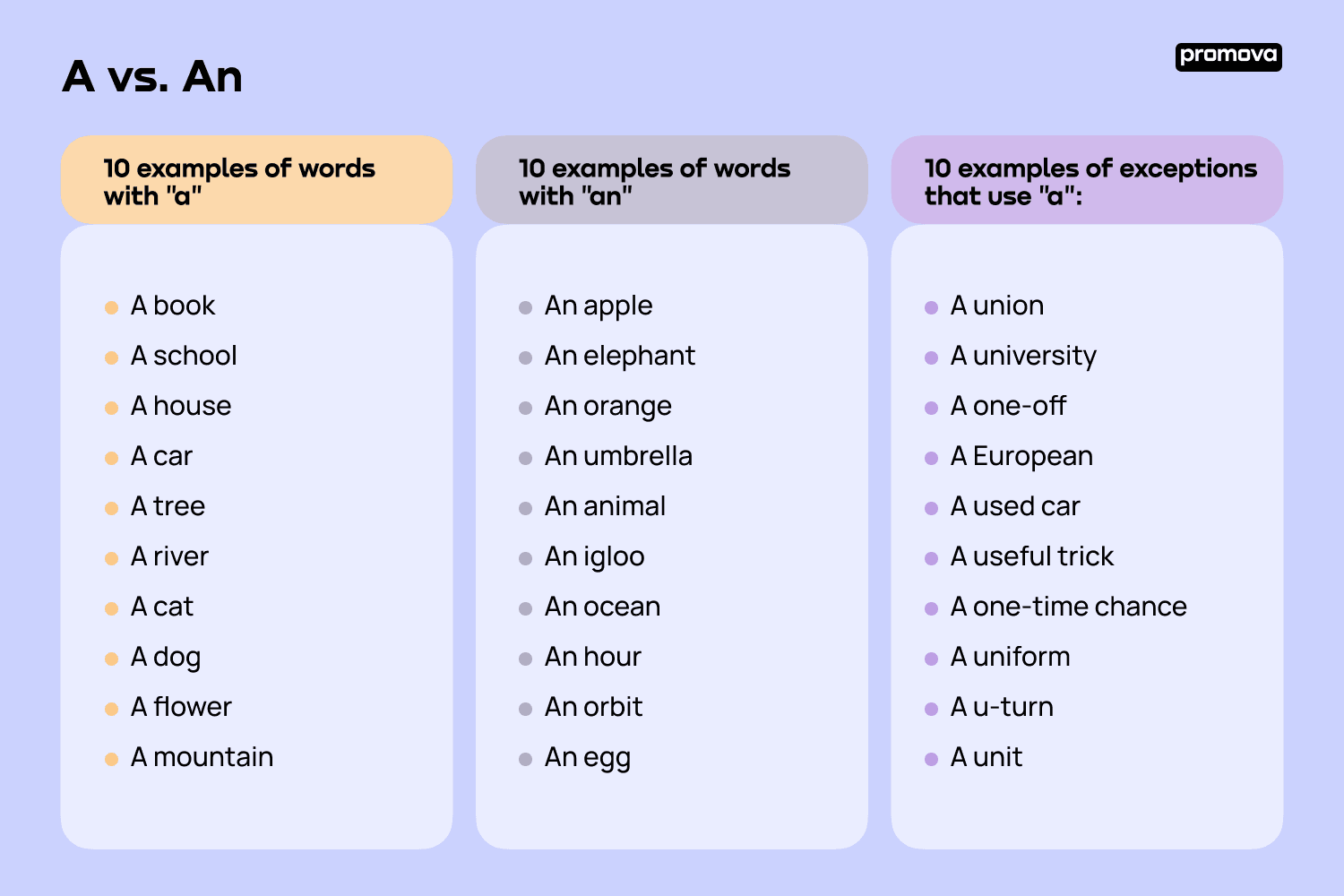Antwort What are the 10 examples of indefinite article? Weitere Antworten – What are the 4 indefinite articles

In English, there are only two indefinite articles, "a" and "an." In Spanish, there are four indefinite articles, un, una, unos, and unas. Spanish and English have different grammatical rules concerning when indefinite articles are needed or should be omitted.Examples
- a boy.
- an apple.
- a car.
- a helicopter.
- an elephant.
- a big elephant.
- an itchy sweater.
- an ugly duck.
There are only two different forms of indefinite articles: ein is used with both masculine and neuter nouns, as in ein Mann (a man) and ein Kind (a child). For feminine nouns, the form of the article is eine, as in eine Frau.

What are the 10 examples of definite articles : Examples
- The sun rose at 6:17 this morning.
- You can go anywhere in the world.
- Clouds drifted across the sky.
- The president will be speaking on TV tonight.
- The CEO of Total is coming to our meeting.
What are the 3 French indefinite articles
There are three indefinite articles: un, une, and des. Un is used for masculine singular nouns, une is used for feminine singular nouns, and des is used for masculine and feminine plural nouns.
What are the rules for indefinite articles : Indefinite article: a, a. Place the article before the noun. Place the article before the adjective when the noun is modified by an adjective. Use the to identify specific or definite nouns: nouns that represent things, places, ideas, or persons that can be identified specifically.
Definite and Indefinite Articles (a, an, the)
| COUNT NOUNS | NON-COUNT NOUNS | |
|---|---|---|
| Rule #1 Specific identity not known | a, an | (no article) |
| Rule #2 Specific identity known | the | the |
| Rule #3 All things or things in general | (no article) | (no article) |

In English there are three articles: a, an, and the. Articles are used before nouns or noun equivalents and are a type of adjective.
What are the 3 articles in German
There are three definite articles in German – der, die, das; and two indefinite articles – in eine; German articles are used with the nouns based on their gender – masculine (der), feminine (die), and neuter (das);In English, the definite article is the, and that's it… that's the only definite article! In Italian, there are seven, and they change depending on a noun's gender, number, and starting letter(s). They are: lo, il, l', gli, i, la, le.Uses of the definite article
- To talk about a particular person or thing.
- Before a singular noun meant to represent the whole class.
- Before the names of certain books.
- Before superlative adjectives.
- Before ordinal numbers.
- Before musical instruments.
- As an adverb with comparatives.

Choose between the definite article (le, la, l', les) and the indefinite article (un, une, des, and de) to complete the sentences. Check a French-English dictionary if you need help with the vocabulary.
What are the 5 definite articles in French : Definite Articles
A definite article is specific, it defines the number and gender of the noun it corresponds to. In English, the only definite article is the, whereas in French there are four of them: la, le, l' and les.
What are all the indefinite articles in English : In English, the two indefinite articles are a and an. Like other articles, indefinite articles are invariable.
Where do we not use indefinite article
Use no article before abstract nouns such as feelings or ideas (usually nouns you can't count). wrong: The patience is a virtue. correct: Patience is a virtue. Rule Example Use a or an before a singular noun that you can count.

The articles in English grammar are "the," "a," and "an." English has only one definite article: "the." This is used to refer to a particular person or noun: for instance, "the President of the United States." English has two indefinite articles: "a" and "an." These are used to refer to a non-specific noun: for …The two indefinite articles in English are a and an. The indefinite article an is used to make pronunciation easier when reading a text aloud. The general rule is to use a when the indefinite article precedes a word beginning with a consonant sound and an when it precedes a word starting with a vowel sound.
How do you say beautiful in Germany : The German translation for ''beautiful'' is schön, or wunderschön. If you want to use either term in a sentence, you could say: Das Haus ist schön (''The house is beautiful''), or Du bist so wunderschön. (''You are so beautiful.



